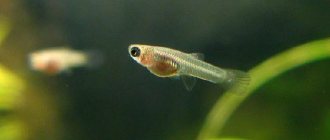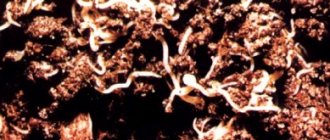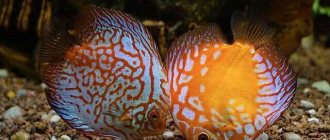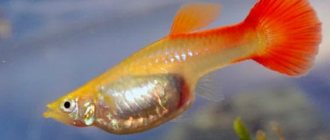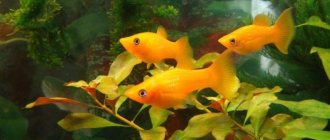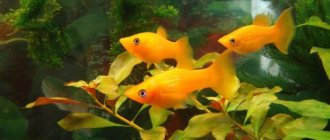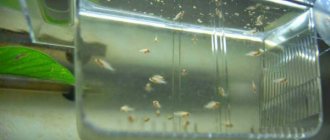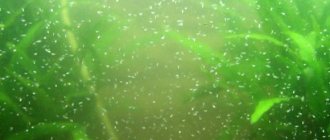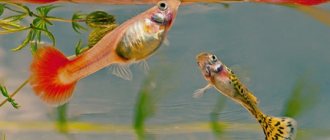Excellent food for fry are slipper ciliates and rotifers . Any aquarist can breed them at home if he wishes, as long as he seriously cares about the health of the little inhabitants of the aquarium.
Ciliate slipper
Rotifers
Rotifers are multicellular animals that were previously considered to be worms. They received their name due to the rotary apparatus, which is the formation of cilia at the anterior end of the body and serves for nutrition and movement of the body in space, swimming or crawling.
Description and structure
The body of animals most often has an oblong, in rare cases spherical shape, which can be divided into 3 sections:
- the anterior head, in which the ciliary apparatus is located;
- torso;
- posterior, where the leg may or may not be present.
In front at the end of the body there are anterior and posterior corollas of cilia and a field of small cilia between them, which together are called the “rotatory apparatus”.
Special retractor muscles can retract the head. All internal organs are located in the body, at the end of which at the back, above the base of the leg, is the cloaca. A leg is a muscular outgrowth on the body that allows rotifers to move by crawling. It has so-called fingers with glands that provide the ability to attach to nutritious matter.
Crawling representatives of rotifers have a large, uniform ciliary space, while swimming representatives have a smaller space, with united cilia. In planktonic individuals, growths can be observed on the sides of the body, which can be designated as “ears,” thanks to which they can swim and control their body more successfully. Also, some individuals may have “arms” - rod-shaped and feather-shaped limbs that allow them to jump and push off from the surface.
Learn how to feed Gammarus, Cyclops and Daphnia as fish food.
The average size of these animals is 2 mm, and some members of the rotifer class can be 40 microns, or 0.04 mm tall. Since their dimensions are very small, the body tissues of these animals have a syncytial structure, and their cells are not completely demarcated. Their cellular composition is constant with the same number in all individuals belonging to the same species.
Rotifers with soft bodies can easily change their shape and shrink. They can be quite large in size, about 2.5 mm, and look like a sac; permanently swimming representatives may have no leg. The body of these multicellular organisms is colorless and takes on one color or another depending on what it has eaten and what is in its digestive system.
Life cycle features
A distinctive feature of the life cycle of these tiny animals is heterogony, which is the alternation of parthenogenetic and sexual reproduction.
If the conditions for the life of rotifers are favorable, then the population consists only of female representatives who produce their own kind; the germ cells develop in the adult body without fertilization - the parthenogenetic method.
If there is a danger to the population, be it drying out of the habitat, climate change or other external factors, haploid males appear in the population, which fertilize the females, and eggs with a protective thick shell are born that can withstand all threats. When the environment improves, females are born again.
Did you know? Rotifers have the ability, when unfavorable environmental conditions arise, to enter the process of cryptobiosis. This means dehydration of tissues in order to avoid death of the body. All vital processes are reduced to zero.
Rotifers can live in temperatures ranging from 2 to 37 °C, depending on what species they are - thermophilic, preferring warm temperatures, or thermophobic, preferring cold.
The life of males is very short, they exist for 2–4 days, and females can live up to one and a half months. The entire surface of the body of rotifers breathes.
These animals mostly feed on vegetation and eat microalgae. There are representatives that consume bacteria and sludge, there are both predators and omnivorous representatives.
Significance in aquarium keeping
In aquarium practice, rotifers are used as food organisms, as they are also called, “living dust,” together with nauplii of crustaceans and ciliates. This food is the starting food, the very first in the process of feeding and growing many species of fish. Basically, planktonic animals, whose size is 0.5 mm, are used for these purposes.
Aquarists prefer this type of feeding for fry due to the fact that rotifers are very nutritious and have the ability to reproduce quickly.
Important! To store rotifers, it is better to choose a vessel with a large surface for better aeration or to provide it additionally. The ideal water for breeding would be the same water from which they were caught and the temperature of which should be no more than 15 °C.
Breeding Daphnia and Cyclops.
Daphnia and Cyclops, representatives of aquatic lower crustaceans. They are caught in reservoirs with a net stretched over a hoop with a nylon bag with an elongated handle.
In summer, a container with daphnia can be kept outside, on the balcony or in the country house. At the dacha, this is especially convenient - put an iron barrel with water, put the crop in there and collect your own harvest. The productivity of such a barrel is quite high even without additional feeding. At home you have to use old aquariums, various vessels and even just glass jars. Of course, the larger the container, the greater the harvest you can get from it, but even from a couple of three-liter jars you can get a good harvest for regularly feeding a small number of small fish.
- Prepare a clean container (volume 25-50 liters) either glass or food-grade plastic.
- Fill the container with tap water that has been standing for at least 2-3 days.
- Install the air blower from the aquarium compressor into the container.
- Introduce into the container live daphnia caught either in some pond or obtained from a familiar aquarist.
- If the room in which the container with live daphnia is located is cool, then it is necessary to install a temperature-controlled aquarium heater (50-100 W) in the container with daphnia, set at 24-26 degrees Celsius.
- Regularly remove dead daphnia from a container with live daphnia by draining them from the container with a thin tube; an air hose is suitable for supplying air from a microcompressor to the aquarium.
Feeding Daphnia culture:
- Take 10-15 grams of dry baker's yeast (yeast is necessary for unleavened dough) and dissolve it in 100-150 ml of warm water and add it to a container with live daphnia in small portions until the water acquires the color of milk, heavily diluted with water.
- Add the yeast solution to a container with live daphnia only after the water in the container in which they are located becomes crystal clear.
- In addition to the yeast solution, you can add 50-100 ml of water with blood from the washed meat to the container with live daphnia.
Valuable note: a daphnia culture feeding primarily on yeast is much more frail and less nutritious than a culture using “green water”. So it’s worth spending some time to ensure that the water turns green well, and also try to diversify your diet. If chlorella is not mined somewhere, then manure and ammonium nitrate - for sure! Saltpeter (NH4NO3) is added once or twice a week, 1g per 100l.
Keep in mind that after a few months the daphnia culture begins to deplete, in which case it is recommended to arrange a “wintering” for them in order to stimulate the laying of ephippia . This can be achieved simply - just gradually reduce the intensity of feeding, and then stop feeding the crop altogether and lower the temperature slightly, so that within a week the entire population will die out and a mass of ephippia . To better stimulate the ephippia, you can freeze them for several days in the freezer or dry them. After such an artificial diapause, the culture begins to grow with renewed vigor.
Cyclops can also be bred under the same conditions , but it must be taken into account that their fertility and reproduction rate are lower than those of daphnia. The larvae, nauplii, emerging from the egg sacs of females are good food for newborn fry and, together with rotifers , form the basis of natural “living dust”. However, you should be careful when feeding fry with adult cyclops; large cyclops can attack small fry and even kill them. The advantage of Cyclops is that, unlike daphnia, they do not have such a pronounced winter diapause and their population is easier to maintain throughout the year.
Main types of “living dust”
The most famous and common types of rotifers are:
- Asplanchna priodonta (Asplanchin) is a freshwater, planktonic animal. Size 0.28–1.5 mm. Adults are predators whose food is ciliates and smaller relatives. They live their entire lives in water, being on the move. They move in such a way that the mouth opening is in front, but the animal itself does not rotate. The body is transparent and spherical in shape. Serves as a nutritional supplement to the main feed, most often when small feed is replaced by large feed. They are not used as a separate food because they do not contain enough calories.
- Brachionus calyciflorus (Brachius Caliciflorus) - freshwater. Size 0.1–0.57 mm. They feed on vegetation. The female is capable of laying offspring twice a day; they mature in 24 hours and live for up to 3 weeks. Very nutritious, used as food for freshwater and marine fish.
The most popular aquarium fish are: guppies, swordtails, zebrafish, barbs, goldfish, gourami and bettas.
- Brachionus plicatilis is a euryhaline species of rotifer that can only live in water with a salt content of 1–90%. Size 0.08–0.3 mm. They eat bacteria and phytoplankton. Males, representatives of this species, can live only a couple of days, and females - a couple of weeks. Individuals grow in a day and a half. They have the ability to reproduce quickly and are unpretentious to living conditions. They are highly nutritious.
- Brachionus rubens (Brachius Rubens) is a freshwater animal. Dimensions 0.1–0.3 mm. Eats planktonic algae. Twice a day, a female produces from three to a dozen eggs of offspring, which mature within a day, subject to the optimal temperature regime of 22–32 ° C. Individuals live for a week or two, often attaching to the surface of daphnia. It does not expend energy on movement, but, being in a calm state, filters food particles.
- Philodina acuticornis (Philodina Acuticornis) is a freshwater representative, often found in the mud at the bottom of aquariums. Food consists of bacteria and algae. The body shape is cone-shaped with a “leg” and a “grasping fork.” These rotifers move slowly, crawl or swim slowly. Each female can reproduce 50 eggs, which can survive in temperatures of 24–27 °C. They live on average for almost a month.
